#giant plants
Explore tagged Tumblr posts
Text
Highlight: I'm getting berry bitty/Thumbelina vibes
She's a berry bitty queen with berry big possibilities. A manocki illustration. This friend be slaying.
instagram
#black art#black artwork#black characters#illustrations#dark skinned girls#black queen#black queens#black girl#black girls#black girl art#dark skin#dark skin is beautiful#bald#no hair don't care#no hair#bald queens#bald is beautiful#outside the beauty box#beauty#black beauties#art#artists#illustration#leaves#giant plants#aesthetic#whimsy#creativity#shoutout#highlight
3 notes
·
View notes
Text
Attack of the Giant Tulip
The first leaves to part the soil were thick as the hide of a rhino, the stem, several inches in diameter puckered with growth, expanding to the width of a tree trunk. The ladies of the garden club assumed it was a mutation. It would die before blooming! But, the vascular power of the plant (now as wide as a house) drained the duck pond. Roots engulfed the church basement, swelled to plug sewage pipes.
At the tip of the central stem a great bud had begun to form.
The first calls to "cut it down!" began. For a flower it was unseemly. Not elegant, not delicate, a beastly vegetable with none of the charms of dainty pansies or cherry blossoms.
It was an abomination!
But, its peculiar nature also served to protect the strange plant from the ax and the chain saw.
The ladies of the garden club knew *objectively* none of the flower shows could denny them a trophy now. (How they imagined to pot and transplant the plant to be shown, I do not know.)
In the balmy days of July the growth continued. Now the great tulip seemed less intent on swallowing the town whole and focused on refining and strengthening its existing form. The leaves darkened and acquired a pattern of fine glossy scales with sharp edges. The stem was ringed and decorated with blade-like ridges of such a vibrant, bright, neon-green that they seemed to glow for several hours after sunset, tattooing the plant with a tracery of graceful swirling geometric curves.
Thorns formed at the base of the leaves, and around the collar of the bud.
The bud darkened, and seemed to shrink, as if tightening itself like a spring, as if winding up to deliver a punch.
What would happen when the bloom was unleashed?
Perhaps is was this fear and question that lead Thurston, who lived two houses down to try his hand at taking a chainsaw to the plant.
Later some would say that he wanted to steal the flower, to sell it, but personally I think he was just frightened.
A chainsaw isn't the right tool for cutting wet vegetable matter. The application of gnashing violence to the the stem resulted in masses of sticky green pulp, the wet plant matter piled up around Thurston's knees, it clung to his face and arms. No matter how hard he pressed the chainsaw into the stem he failed to make significant progress, and only released more of the sticky green material.
And laced as it was with those bladed ridges he soon found himself covered in fine cuts.
According to the coroner, who had to be called in from Trenton, the cause of death was anaphylactic shock. Thurston had an undiagnosed allergy to the pulp of tulip stems.
But, I don't think anyone really believed that was all there was to it.
The man had tried to kill the plant and the plant had fought back and gotten the better of him. The plant had taken revenge.
In only a few days you could hardly tell that an attempt to cut that great stem had been made at all. [to be continued]
#flowers#plants#story#giant plants#giant flower#tulip#plants that murder#to be continued#writing#fiction
10 notes
·
View notes
Text


2 notes
·
View notes
Text

Telleris' lighthouse 🌊
#environment art#environment design#imaginary landscape#imaginary world#seaside#ocean#lighthouse#giant plants#original concept#fantasy world#worldbuilding#my art#personal project#artoflumeria
8 notes
·
View notes
Text

Pitcher Plant 🌱✨
•
project for my visual communications class :>
#pitcher plant#pitcher plants#plants#leaves#world record#plant art#plant painting#giant pitcher plant#giant plants#stardustedtea#digital painting#digital artwork#pink and green#big leaf#art student#visual communication#class assignment#digital artist#pink hair#swimming
3 notes
·
View notes
Text
From speaking of these colossal plants, Ned, Conseil, and I naturally deviated to the gigantic animals of the sea.
"20,000 Leagues Under the Sea" - Jules Verne
#book quote#20000 leagues under the sea#twenty thousand leagues under the sea#jules verne#underwater plants#underwater animals#giant plants#giant animals#conversation#observations#ned land#professor aronnax#conseil
1 note
·
View note
Text


1 note
·
View note
Text

1 note
·
View note
Text




giant african land snails (archachatina marginata) | msk.snails on ig
#stim#snails#animals#giant african land snail#sfw#brown#green#beige#shiny#gastropods#molluscs#archachatina marginata#leaves#plants#hands#ishy gifs#requests#postish
951 notes
·
View notes
Text

Mr Qi gives me the vibe of an eldritch being that is not bound by the laws of our reality, but chooses to abide by them anyways. And if you've read my comic, you can probably guess I can't resist that kind of thing.
animated version (flash/eyestrain warning)
#sdv#sdv mr qi#stardew valley#fanart#i absolutely hate qi fruit tho#the new giant one is cursed#mr qi why does the plant have to have your face on it#w h y
1K notes
·
View notes
Text






Львиный зев большой, львиный зев крупный (лат. Antirrhinum majus). Октябрь 24. Snapdragon Giant . October 24.
#русский tumblr#Россия#природа#осень#городскойпейзаж#травянистое растение#цветы#Львиный зев большой#мои фото#макрофото#Russia#autumn#nature#cityscape#herbaceous plant#flowers#Snapdragon Giant#bloomcore#my photos#nature photography#original photography#photographers on tumblr#macro photography
204 notes
·
View notes
Text

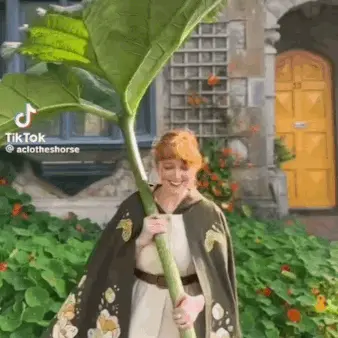

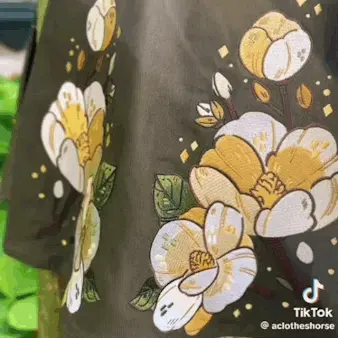
☘️
#stimboard#moodboard#stim#plants#leaf#borrowers#giant things#cape#flowers#dog#irish wolfhound#visual stim#tactile stim#hands#irl people#fairycore#brown#green#white#yellow#grey#gray#cottagecore
287 notes
·
View notes
Text
「Demo WIP」 Can y'all watch my plant real quick? 🍈
#Y'all ever plant a Filipino cantaloupe and it just randomly grows into a giant human overnight? No??? Just me???????#Anyways!! Don't be fooled this is literally just reskinned Ren Bot from Discord lmao#The RenPy to Pycord back to RenPy pipeline is real#Will I ever come back to this project?? Mayhaps not.... We'll see#My plan is to turn it into a comfy window game that you can have running in the background#It'll play some lo-fi beats and let you feed/pet Sage every so often to level their affection meters#Higher affection will yield better responses + maybe an outfit/scenery change#You can also talk to them the same way you talk to Ren Bot (for those familiar with him in the Discord server)#So you could like.... talk about your day and Sage will listen ^^#I also wanna add a dynamic background that corresponds to your local computer time.... If I feel ambitious enough hehe#But for now?? lazy 2 hour sketches featuring MAD inspo from the FFXIV dancer gear bghsdjgd#game dev#visual novel#maybe???? is she??#clicker game? pet sim?? knock-off honeydew Tamagotchi?? we just don't know#queue.#to be tagged later
268 notes
·
View notes
Text



Plant of the Day
Tuesday 28 January 2025
Usually described as a large and long-lived evergreen specimen for a large park or garden Sequoiadendron giganteum (giant redwood, big tree, giant sequoia, mammoth tree, Sierra redwood, washingtonia, wellingtonia) these trees were planted many decades ago in a garden and churchyard either side of a road in this village in Essex, UK. They were a great feature as a view from a cafe window.
Jill Raggett
#Sequoiadendron#giant redwood#big tree#giant sequoia#mammoth tree#Sierra redwood#washingtonia#wellingtonia#village#essex#Great Waltham#evergreen#conifer#tree#horticulture#garden#gardens#plants#front garden
69 notes
·
View notes
Text
GR96
@fusionspruntcityjournal
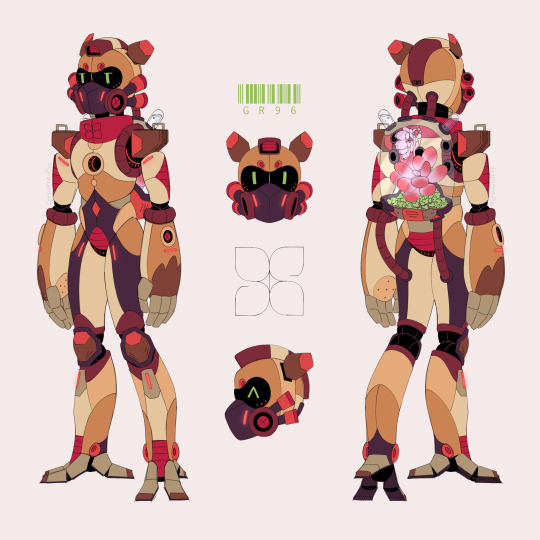
So how do you produce electricity with living plants? Simply by using the natural processes that already occur. In short: the plant produces organic matter via photosynthesis. Only part of this organic matter is then used for its own growth. The rest is excreted via the roots. Around the roots, bacteria feed on the organic matter and they release electrons. If you’re able to harvest the electrons into an electrode, you can couple the first electrode to a counter-electrode and build an electrical circuit, like in a battery. The electrons flow back into the natural system via the counter-electrode, so it’s completely circular. Because we use the natural processes around the plant, nature is not harmed. It works day and night, summer and winter. It only stops when the plant and its surroundings completely dry up or freeze over.
Sedum Oviferum
Sedum pachyphyllum is a ground-hugging succulent that spreads by rooting fallen stems and leaves. The succulent also goes by the names “Cerise Moonstones” or “Mauve Pebbles”. The short and stumpy round leaves have a light silvery-purple color; positioned at a right angles to the stem and curve upward, which in the wintertime, the tips of said leaves will turn into a notorious red.
Sedum Oviferum is a succulent that is very easy to grow and maintain. It is a resilient plant that can tolerate drought, moist and dry soils, and when given adequate exposure to sunlight and sufficient water, Cerise Moonstones will thrive outdoors. The Sedum Oviferum succulent grows at its best with regular exposure to sunlight. If Mauve Pebbles are planted in an area in a garden that gets plenty of sunlight per day, you will be rewarded with bright coloured leaves and flowers. In winter and early spring, Cerise Moonstones actively grow and produce blooms featuring red-orange petals and sepals that have the same pigmentation as the leaves. The flowers produced by Cerise Moonstones have a bell shape and a sugary fragrance.
Subterranean Clover
Trifolium subterraneum is also known as the subterranean clover (often shortened to sub clover), or subterranean trefoil. The plant's name comes from its underground seed development, a characteristic not possessed by other clovers. It can thrive in poor-quality soil where other clovers cannot survive.
This species is self-fertilizing, unlike most legume forage crops such as alfalfa and other clovers, which are pollinated by insects, especially honeybees. It is also grown in places where the extreme ranges of soil type and quality, rainfall, and temperature make the variable tolerances of sub clover especially useful.
Functionality
GR96 are powered by any plant of choosing on their back pod (the one we are going to discuss has a giant Sedum Oviferum and multiple sub clovers to operate) which is held in place by five strong suction cups. They’re manufactured for community gardens (strictly only one per garden), but they can also be bought by high class citizens for private properties, though at a way bigger cost since they’re financed by the city.
They can use their hands as scissors, shovels, and for watering (hence the big forearms, for storing the water), the latter which they do by dipping their hands in a bucket, opening the valve on their forearms so they can fill them up and releasing the water from the pinholes on their palms. Their “eyes” are actually a screen that can show plenty expressions, but the two circles above that peripheral screen are the real environmental sensors. They also have the same sensors on their ankles for inspecting the lower plants and ground without the need of kneeling, and their feet are shaped in a way so that weight is evenly distributed, lowering the chances of damaging a plant if they were to step on it. The ear like protrusions are small solar panels, used as backup energy (they don’t have any communication properties). Their speaker aka their “voice” is the mohawk-like structure on the top (which also has their series barcode 128 on the lower back), but when they speak there are these strips at the sides of the face mask that light up with the volume. The mask (non removable) has a set of pipes that are used for analyzing the air quality and humidity of the area surrounding them.
#my art#fusionsprunt#fusionsprunt oc#fusionsprunt clover#i’ll reblog this again later with their lore and alt design#the sedum oviferum is a fictional succulent i came up with since i couldn’t find one that i liked lmao#literally said fuck it it’s my oc i make the rules#[slaps a giant plant inside]#the energy gathering segment is based on a real article!#in its current state it can only power small leds#but i like to imagine a future where that energy could power full fledged robots :0
195 notes
·
View notes
Text
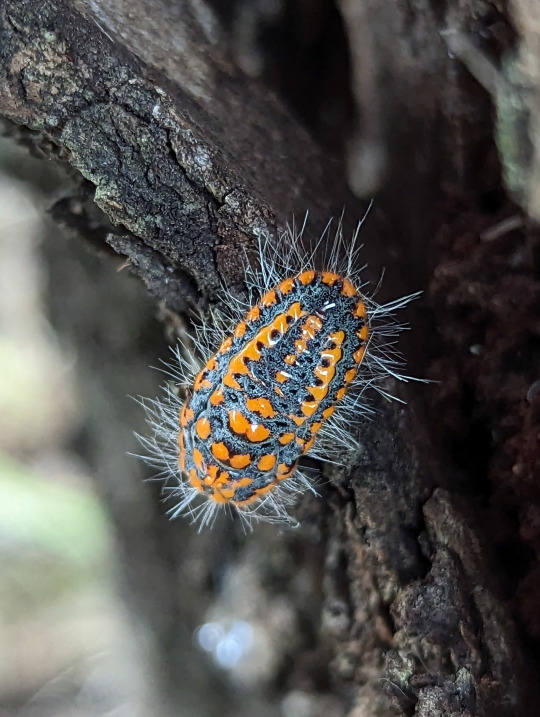

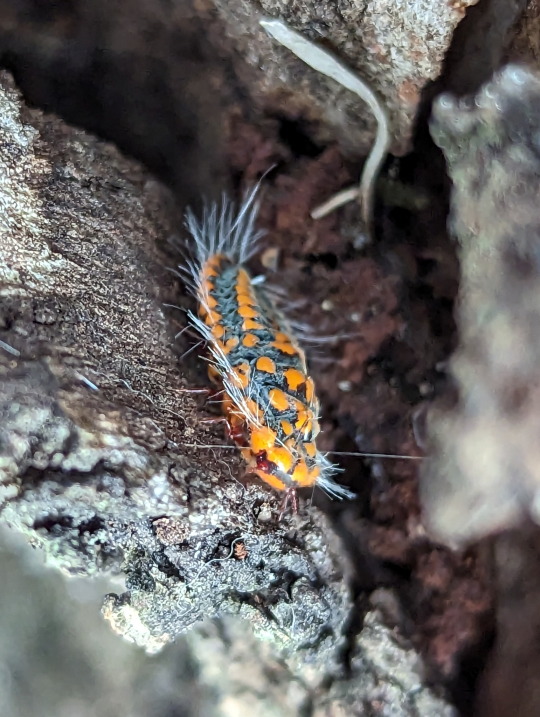
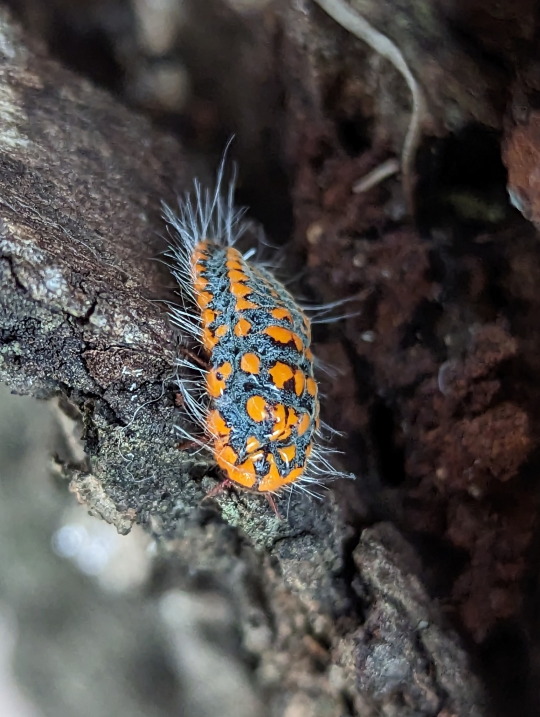

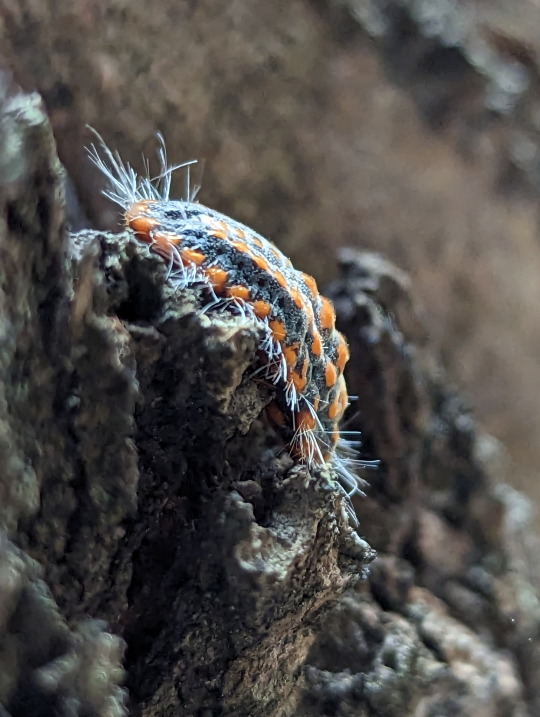
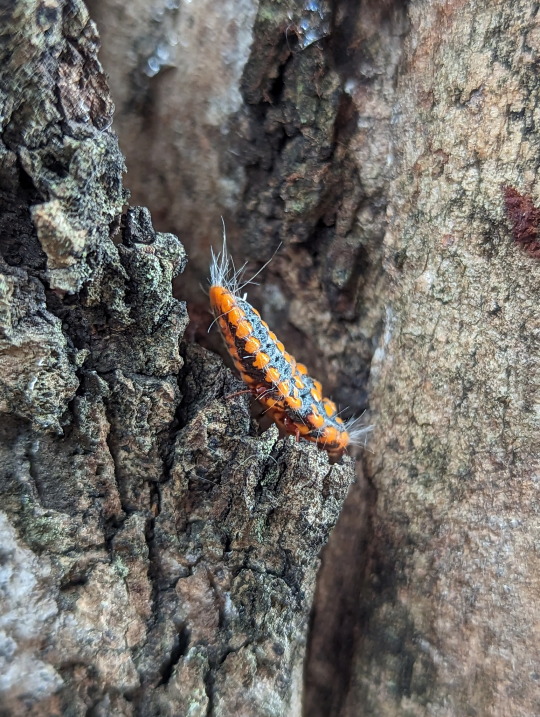
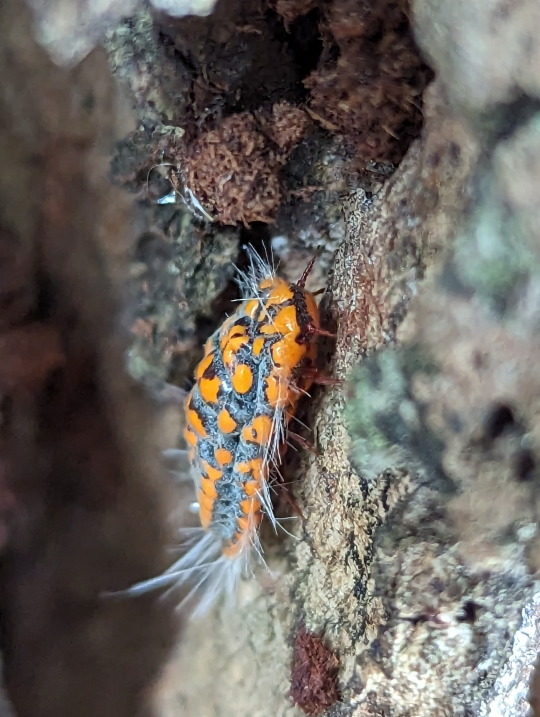
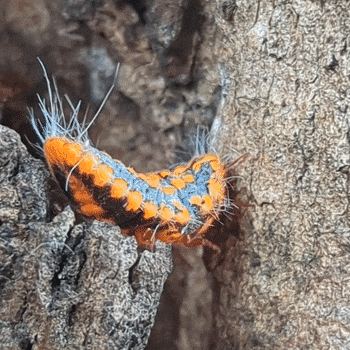

Giant Scale Insect
I got a bit of a shock when I saw this thing.
At first I thought it might've been the larva of those big leaf beetles I found. Was very surprised to discover it was a scale insect.
Unidentified, genus Monophlebulus
28/03/23
#Monophlebulus#unidentified#Giant Scale Insects#Monophlebidae#Coccoidea#Scale Insects#Sternorrhyncha#Plant-parasitic Hemipterans#Hemiptera#gifs#invertblr#invertebrates#Arthropods#Arthropoda#bugs#bugblr#bugs tw#insects#insecta#insectblr#entomology
910 notes
·
View notes